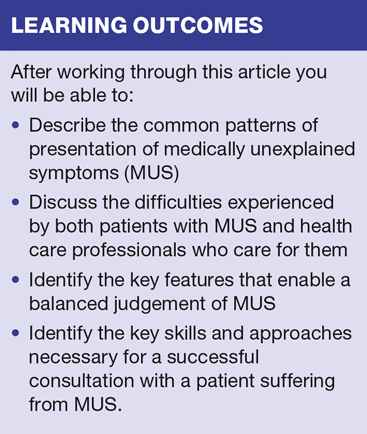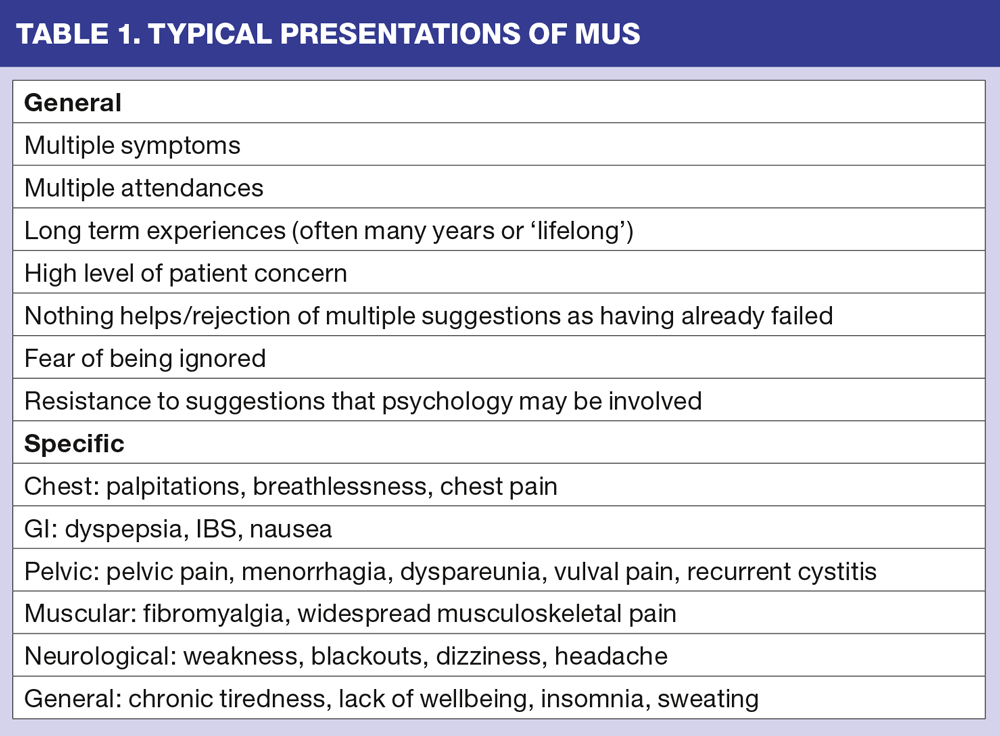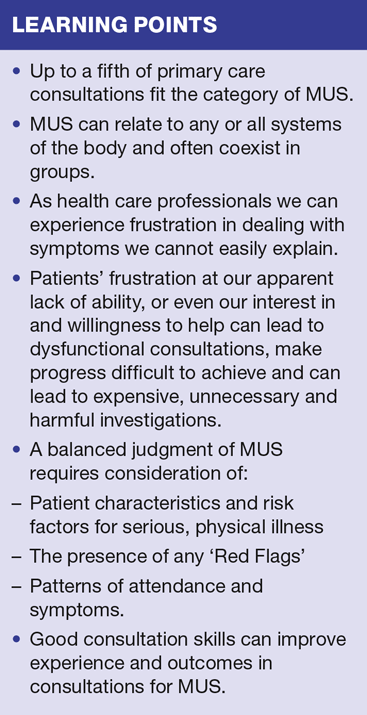Medically Unexplained Symptoms
Dr Mary Lowth
Dr Mary Lowth
MA MB BChir FRCGP PGCMedE
GP and MRCGP examiner
Medically unexplained symptoms can lead to frustrating, dysfunctional and unhappy consultations, lack of progress and expensive, unnecessary and potentially harmful investigations. Good consultation skills and balanced judgement can improve outcomes
The term medically unexplained symptoms, or MUS, is used to mean symptoms which don’t correspond to visible or structural physical abnormalities. MUS therefore covers conditions as diverse as irritable bowel syndrome (IBS) and chronic fatigue.
Most of you will have seen patients with MUS and will be familiar with the sense of frustration at not being able to offer straightforward physical solutions. The frustrations we feel in dealing with symptoms we cannot easily explain is nothing compared to patients’ frustration at our apparent lack of ability, or even our lack of interest or unwillingness to help. This easily leads to dysfunctional and unhappy consultations, and can make progress difficult to achieve. It can also lead to expensive, unnecessary and harmful investigations.
In this article we look at the common threads in MUS, the difficulties MUS cause to practitioners and patients, and at strategies for dealing with the consultations they produce.
MUS ARE COMMON
Up to a fifth of primary care consultations fit the category of MUS.1,2 They can relate to any or all systems of the body and often coexist in groups. Anxiety and depression are commonly present, and many MUS can be exacerbated by anxiety and stress. We must be careful, however, not to infer that, because stress is present and makes symptoms worse, it is the only cause.
There are clusters of complaint types: IBS is often associated with chronic pelvic pain and fibromyalgia. About a third of patients present with
multiple – sometimes apparently unrelated – symptoms. Other typical presentations are shown in Table 1.
There is an association of MUS with deprivation, which may also relate to lack of education and fear of unexplained symptoms. Previous abuse is also associated with MUS, particularly chronic pelvic pain.3
SOMATISATION
Somatisation refers to the expression of psychological illness through physical symptoms. It is also used to refer to repeated medical help-seeking for multiple physical symptoms for which no clear or consistent organic pathology can be demonstrated.
Some, but not all, MUS involve somatisation. However MUS also includes patients whose symptoms relate to impaired system function, such as presumed changes in nerve receptor and pain centre sensitivity. Others simply have symptoms we have not yet been able to explain.
PRECONCEPTIONS ABOUT MUS
Just because we cannot explain physical symptoms doesn’t necessarily mean there are no changes present. They may just not be visible to regular investigations.3,4 For example, IBS is certainly a real condition, but it is characterised by widespread and recurrent symptoms with negative investigation findings. It is a disorder of bowel function rather than structure. It’s important to remember the distinction. If something doesn’t work in a satisfactory way but looks normal it does not mean the problems are mild, minor or psychological. Functional disorders are distressing to patients and are often chronic and long lasting.
Some symptoms are unexplained because of deficiencies in our medical knowledge and medical science has a long history of not being right. In ancient Greece physicians agreed on the humoral theory; when the four humors, blood, phlegm, black and yellow bile in the human body were in balance, good health was guaranteed. An imbalance was believed to be the cause of ill health. Bloodletting using leeches was one method used to balance the humors. We still get things wrong today. The case study provides a cautionary tale.
PARTIALLY UNEXPLAINED SYMPTOMS
In some conditions the spectrum of symptoms patients feel is not linked by equivalent physical processes. Some MUS are only partially explained by physical processes, and we have some understanding of what gives rise to the rest. Back pain is an example; the level of pain and disability is often unrelated to the degree of physical change seen on MRI. Clearly there is nerve activity – and brain activity – involved in this pain that we cannot see or measure. Our problem is that because we can’t demonstrate a physical process we cannot be certain that we are right.
In these situations we must rely on pattern recognition, including patient characteristics like risk factors and lack of sinister features, to make our diagnosis. We then need the confidence and skill to explain this to patients in ways that make sense to them and alleviates their fears.
WHAT ARE YOU MISSING?
MUS often involve fear in the mind of the patient at the thought of the undetected presence of serious illness.
Most of the time we can appropriately reassure patients that this is not the case, explaining what their symptoms signify and how they differ from the red flags which we are looking for as markers of sinister conditions. However, we all eventually die and this includes those who attend the surgery frequently with MUS. A long history of frequent presentation can blind us to new or worsening symptoms. We therefore need to stay alert for red flags and unusual symptoms while keeping a balanced view and trying to avoid unnecessary investigations.
MAKING A BALANCED JUDGEMENT
Patient characteristics
Common things are common. We know, for example, that young men do not tend to present with prostate cancer. This is not certain, as nothing ever is in medicine, but it’s highly likely. So look at the patient. How old are they. Could they have something serious?
Risk factors
The advent of the QOF has made us all expert in assessing cardiovascular risk. So when a patient with a 10-year risk of CVD of less than 3% presents with chest pain it is unlikely to be an MI. It can be, but you would need some clear supporting evidence before sending that patient for cardiac catheterisation, for example.
Red flags
Red flags help us spot serious diagnoses even in unlikely patients. The presence of any red flags mean that re-evaluation of MUS is needed.
Some common MUS symptoms, such as headache, altered bowel habit, chest pain and limp have clear red flag guidance. Others are vaguer and there is little to help us. We must therefore be alert to sudden changes in symptom pattern e.g. altered bowel habit in IBS.
We can be wrong. We must listen carefully to patients, and remember that, while common things are common and we see rare things rarely, rare things do present. As generalists in primary care we may not be best positioned to recognise them.
Attendance and symptoms patterns
Patterns of attendance and presentation over time help us decide how worried we are. It is easier to be alert for serious illnesses in patients who attend rarely, as the very fact that they have attended becomes significant in a way that it is not for the frequent attender.
Apply our knowledge
Studies looking at whether we miss sinister causes of MUS are relatively reassuring, but one small study showed that in primary care, 10% of MUS symptoms present for several months turned out to be organic disease – so we could be wrong about 10% of the time.3
Phone a friend…
Specialists, on the other hand, are wrong only 2-3% of the time – so we need to be aware that if any doubt is present in our minds our secondary care colleagues are, quite simply, better than us at spotting rare presentations and rare diseases.
CONSULTATION SKILLS IN MUS3,4
There are a number of skills you can bring to the consultation that will improve experience and outcomes in consultations for MUS. These can be practised, so that you find phrases that work for you, and can tailor them to different patients and their concerns.
History taking
Open positively
Greet patients by name and thank them for coming. Consider collecting them from the waiting room personally.
Don’t ask, as your opening statement, what they want you to do. They may ask for something unachievable today, for example, ‘I want you to finally cure these headaches…’ and this sets a bad start. Instead ask what they would like to talk about today. If it’s a follow up ask how they have progressed since you last met.
Let patients talk
Use open questions to invite the patient’s contribution. If patients feel heard and understood then the foundations for effective management are more likely to be laid.
Be positive
Look forward to trying to help the patient solve their problems with you.
Use deep listening skills
This means listening to everything the patient says. Indicate that you have heard, clarify your understanding and ask questions they can answer, such as ‘How does it feel?’. Then summarise what they have said in their own words, including their worries and fears.
For example: ‘the last doctor fobbed me off…’
‘How did he fob you off?’
Use non-verbal communication skills
This means open, attentive body language, eye contact, empathic tones, mirroring body language.
Acknowledge the reality of symptoms
Don’t let patients think you believe they are imagining or inventing their symptoms – be clear that you have heard and understood.
Acknowledge and examine worries
Give them a chance to discuss their worries. What do they think it is? What’s really worrying them about it? Patients have usually thought a great deal about what it might be, often in the dark hours of the night. They may have looked on the Internet and may have formed a distorted view of the most likely explanations.
Examination
Examine positively, emphasising the good things you find as you find them. Mention how what you find is reassuring you: ‘I am checking your tummy for rebound, which can mean fluid is leaking in the tummy from an inflamed appendix, but you don’t show any signs of that, which is good news.’
Explain symptoms as you examine
For example, explain tender bowel loops in IBS: ’I can see your bowel is very tender and the nerves certainly seem to be very sensitised.’
Be aware of when listening isn’t enough:
- Patients are repeating themselves
- They are enhancing what they say and making it more florid
- They are adding in new symptoms and worries.
Summarising
Acknowledgement
Offer acknowledgment of the patient’s symptoms and distress.
Explanation
Try to provide tangible physical mechanisms for problems; e.g. ‘Stress can make the intestine very sensitive.’
You may say that the body generates misleading pain signals: ‘Pain is just nerve fibres firing, and they may not get the fine tuning right.’ You might offer clear descriptions of centralised pain sensitisation syndromes, describing findings that support your explanation e.g. hypersensitivity to mild stimuli. Explain that pain can be alleviated by psychological means even when the original cause was physical because pain may have been tuned up by the body for so long that it needs help to tune back down again.
Explain why you are not worried about their physical symptoms. Be clear and professional. But let them have their say.
Try to make the diagnosis a positive one – a positive statement of diagnosis rather than a negative statement of absent signs, offering ideas of what it might be rather than lists of what it isn’t.
Effective explanations provide real mechanisms for understanding, linking physical and psychological factors.
Target setting
Focus on areas to improve or work on with realistic targets. For example, you might suggest that, if you worked towards gradually making the headaches less frequent, the patient could keep a diary so that you could review progress; if a patient had a lot of domestic problems you might ask: ‘So if you were going to get on top of all these problems at home, where would you start? What about Citizens Advice?’
Don’t promise complete relief from symptoms. In chronic, long lasting conditions this will not be simple to achieve and may not be possible. Negotiate on aiming for improvement.
Be interested in the outcome
Patients are more likely to respond if they feel you care what happens when they leave your room.
Introduce the idea of psychological therapies
Psychotherapy can be helpful to some patients. If patients see that what they have been doing so far has helped, and that you want to solve it too, they may agree that something different is worth trying. Psychotherapy can modify the experience of symptoms, and change the behavior of the nerves in the brain’s pain centre.5
Follow Up
Offer review if things worsen or don’t settle within an agreed timetable. Tell them what you expect to happen and make sure they can see you, specifically, again if possible. Offering continuity provides better quality care in chronic conditions and demonstrates to the patient that you take their problem seriously.
TEAM WORK
Good record keeping of your consultations is essential so that the whole primary care health team can see the diagnosis and management plan. This will make the approach to management consistent. However, as above, it is important to offer patients continuity so that they don’t feel that your interest really only had to be sustained until they walked out of your door.
WHAT NOT TO DO
We in primary care often make things worse in MUS, both by what we do and by what we don’t do.6
If our explanations are in conflict with patients’ worries and their own thinking about cause then they will feel rejected and lose confidence in us. Reassurance without addressing these ideas and concerns can actually increase the intensity of somatic symptoms.3
Factors that make things worse
- Not appearing to try hard to find a reason (patient thinks you’re not interested)
- Dismissing symptoms before the full history is gathered (patient thinks you’re not thorough)
- Trying to normalise things, telling the patient there is no sign of disease (patient thinks that’s only because you can’t see it today)
- Telling patients you don’t think there’s anything serious going on (patient thinks I don’t care what you think because I think there is)
- Telling them it will settle (patient thinks how do you know if you don’t know what it is?)
- Telling them the test was negative (patient thinks so I need a different test)
- Telling them it’s just stress (patient thinks you’ve given up on me).
COMPLICATIONS OF MUS
Aside from the cost to the NHS, complications may result from invasive testing performed while looking for the cause of the symptoms. Dependencies on pain relievers or sedatives can also develop.3,4
A poor relationship with the primary case doctor or nurse seems to worsen MUS. Evaluation by many providers also often results in increasing symptom experience.
SUMMARY
MUS are a common presentation in primary care. The way in which we interact with affected patients has enormous power to either improve or worsen their symptoms and attendance patterns.
MUS patients who continue a regular attendance pattern tend to develop inflating symptoms and greater anxiety. This puts them at risk in the short term of unnecessary investigations and treatments and iatrogenic harm. In the long term, they risk their attendance pattern lulling primary care staff into a state of reduced alertness for red flags of changing symptoms, so that their worst fears can come to pass.
The practice nurse who spends time listening to patients, investigating their symptoms by thorough history with interest and care can make a real difference, both to patients and to the practice.
REFERENCES
1. Mumford DB, Devereux TA, Maddy PJ, et al. Factors leading to the reporting of ‘functional’ somatic symptoms by general practice attenders. British Journal of General Practice 1991; 41(352):454-8
2. Peveler R, Kilkenny L, Kinmonth AL. Medically unexplained physical symptoms in primary care: a comparison of self-report screening questionnaires and clinical opinion. Journal of Psychosomatic Research 1997;42(3):245-52
3. Burton C (ed) ABC of Medically Unexplained Symptoms: BMJ Books. Wiley-Blackwell 2013
4. Rosendal M, Olesen F, Fink P. Management of medically unexplained symptoms. British Medical Journal 2005;330(7481):4-5.
5. Speckens AE, van Hemert AM, Spinhoven P, et al. Cognitive behavioural therapy for medically unexplained physical symptoms: a randomised controlled trial. British Medical Journal. 1995;311(7016):1328-32.
6. Dowrick CF, Ring A, Humphris GM, et al. Normalisation of unexplained symptoms by general practitioners: a functional typology. British Journal of General Practice 2004;54(500):165-70.
Related articles
View all Articles




